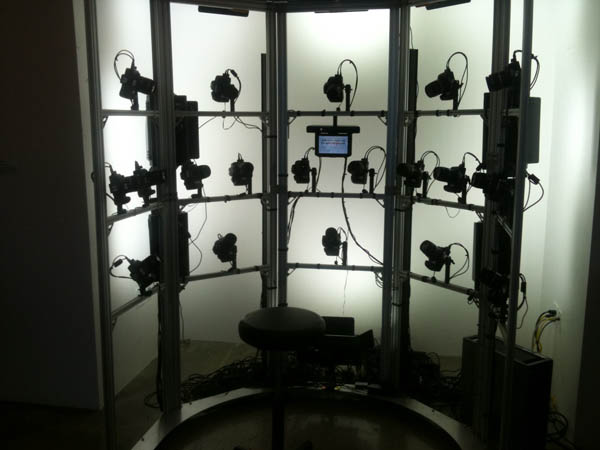

“And what is this? What does it do?,” I asked Jesse Harrington, Autodesk Maker Advocate, whose job it is to camp out at TechShop and help makers with everything Autodesk-related.
“Seriously,” added Andrew Taylor, TechShop’s Event and Marketing Coordinator, “I feel like I’m in the movie Source Code. Have you seen that?”
“Yes! It DOES look like that,” I agreed as I watched Andrew sit down in the chair and slide into what seemed like the appropriate position.
The backlit canopy with a skeletal network of roughly 20 SLR cameras angled at a central focal point had caught our attention as soon as we walked into the room. Jesse explained to us that this was the Photofly project, Autodesk’s new technology that uses digital photographs to create 3D models, while Andrew harmlessly followed the on-screen directions to center the chair.
Then, SNAP! Andrew and I both jumped as all of the cameras shuttered simultaneously. That was it: quick and painless. I took my turn in the chair, and remained unphased as the simul-shutter snapped my photo. I got up to check the results but was disappointed to find that it didn’t instantly create the model. Our attention was quickly captured by one of the other displays in the futuristic Autodesk showroom. I didn’t think much about it until I received a generated email a few hours later, and was blown away when, later that night, I had a 3D model of my head swirling around on my iPhone screen.
It wasn’t the first time I’d heard of Photofly. In fact, the topic was one of the main reasons we made the trip to the Autodesk showroom. Jesse and I were having a casual conversation a few days earlier at TechShop and he inquired into what classes I had been taking recently. I started gushing about the Next Engine 3D scanning class I’d taken the night before – how incredible it was. The class consisted of me and only one other student. We spent time going through the process of setting up the scanner, running a scan, then manipulating and cleaning up the image in software. Because we only had two students, we had time at the end of class to discuss projects we planned to use with the scanner. I, of course, was there on an educational mission, but the other student’s project was fascinating: he wanted to scan sea shells. The unique shape of a shells was a perfect use-case for the Next Engine. We discussed the intricacies of the shell, the process for combining images and scans of both the outer and inside views of the shell – quite a challenging use, but perfect for discussing the unique advantages and limits of the technology. So far, I’d spent most of my time on the CNC machines that take digital designs, and with the aid and ease of technology, turn them into physical objects. I had been totally ignorant of the scanning technology that takes real, physical objects and turns them into digital bits – making them malleable and compatible with computer-aided design (CAD) programs. Of course, telling all this to Jesse was preaching to the choir. He could sense my excitement, which is why he mentioned Photofly and suggested the tour at Autodesk.
The whole experience – the class, tour, and discussion – left me with a sense of amazement over this technology. I wasn’t, however, able to imagine how this could make an important impact. It seemed a little like a novelty – fun to play with but not practically useful. It wasn’t until I read a short entry on the MakerBot blog that everything came full-circle: Project Shellter: Can MakerBot’s Save the Hermit Crab Community. The story profiles Miles Lightwood, MakerBot’s artist in residence, as he and the team set out to crowdsource a solution to the hermit crab habitat shortage.
Wow. What if my fellow student, someone with only a few hours of training at TechShop, is able to leverage this technology to create a habitat solution for these creatures? How cool is that? My Zero to Maker journey continues to re-inspire me with such possibilities!
More:
Follow David’s Zero to Maker exploits
ADVERTISEMENT







